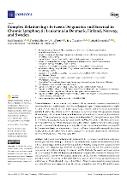Complex Relationships between Diagnostics and Survival in Chronic Lymphocytic Leukemia in Denmark, Finland, Norway, and Sweden

Author
Försti, Asta
Tapaninen, Tuija
Hemminki, Akseli
Juliusson, Gunnar
Niemann, Carsten Utoft
Publication date
2024Published in
CancersVolume / Issue
16 (18)ISBN / ISSN
ISSN: 2072-6694ISBN / ISSN
eISSN: 2072-6694Metadata
Show full item recordCollections
This publication has a published version with DOI 10.3390/cancers16183229
Abstract
BACKGROUND: Chronic lymphocytic leukemia (CLL) is a common hematological malignancy with highly variable clinical presentation. Many patients never require any treatment but for the others, chemotherapy, immunochemotherapy, and newer targeted therapies have changed the treatment landscape. Diagnostic age influences the applied treatment, and we thus wanted to analyze age-specific survival trends through 50 years up to 2020s. METHODS: We used 1- and 5-year relative survival from the NORDCAN database, with data from Denmark (DK), Finland (FI), Norway (NO), and Sweden (SE). Because of the variable presentation of CLL, we also considered incidence and mortality trends. For comparison, US SEER data were used. RESULTS: The large age-specific survival differences in 1972-76 almost disappeared by 2017-21. While 5-year survival in younger patients exceeded 90%, for those diagnosed at age 80-89 years, survival reached 90% in DK and SE women, 80% in NO and SE men, but only 50% in FI. DK 5-year overall survival for men was 92.4%, and for women, it was 96.3%. These survival figures were higher than age-group-specific US survival data. CONCLUSIONS: The DK data are probably global top figures for national survival which could be achieved by boosting survival even among the oldest patients. The qualification to these figures and international comparisons is that survival needs to be considered in terms of incidence, which is high in DK and NO. Low survival of the FI 80-89-year-old patients, even in the first year after diagnosis, may suggest delayed diagnosis, which should call for a closer national scrutiny.
Keywords
periodic survival, prognosis, targeted agents, treatment
Permanent link
https://hdl.handle.net/20.500.14178/2725License
Full text of this result is licensed under: Creative Commons Uveďte původ 4.0 International





